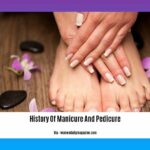Are you ready to unlock the hidden secrets of your toenails? Get ready for an intriguing journey into the captivating world of fascinating toenail facts! As a seasoned health and wellness writer with expertise in dermatology, I am here to delve into the lesser-known aspects of this often overlooked body part. From the intricate structure of nails to common conditions that affect them, prepare to be amazed by the wealth of knowledge and insight that awaits you. Join me as we explore the enchanting world of toenails and uncover the secrets that lie beneath.

Fascinating Facts About Toenails
Toenails may seem like a small and insignificant part of our bodies, but they actually hold a multitude of interesting secrets that are worth exploring. From their structure to their growth patterns and common conditions, here are some fascinating facts about toenails.
1. The Hard Proteins: Just like their counterparts, fingernails, toenails are composed of a hard, organic protein called alpha-keratin. This tough substance covers the tips of our toes, protecting the delicate tissue underneath. It’s amazing how something as small as a toenail can be so resilient!
“Toenails are made up of a remarkable protein called alpha-keratin, which provides them with their remarkable strength and durability.”
2. The Integumentary System: Toenails are an essential part of our integumentary system, which includes our skin, hair, and nails. This system acts as a protective barrier, shielding our bodies from external factors. So, next time you admire your pedicured toenails, remember that they are part of a complex network of defenses.
“Our toenails are integral to the intricate network that is our integumentary system, protecting our toes from the elements.”
3. The Four Main Parts: To understand toenails better, let’s break them down into their four main components: the cuticle, the matrix, the nail bed, and the nail plate. The cuticle acts as a barrier, preventing bacteria and fungi from entering the nail. The matrix is responsible for nail growth, while the nail bed provides a solid surface for the nail plate. It’s fascinating how these parts work together to form a complete nail!
“Toenails consist of several distinct elements: the cuticle, matrix, nail bed, and nail plate, each with its unique function in creating the perfect toenail.”
4. Vulnerability to Trauma: Despite their sturdy nature, toenails can be susceptible to physical trauma, such as injuries caused by objects. When a toenail experiences a strong impact or gets caught in something, it may crack or even detach from the nail bed. This can be painful and require appropriate care to promote healing. So, be mindful of how you protect your precious toenails!
“While toenails are remarkably strong, they can still be vulnerable to physical trauma, like bumping into objects or getting accidentally caught. These incidents can lead to painful cracks or even complete detachment of the nail.”
5. The Need for Nourishment: Like any part of our body, toenails require blood, oxygen, and nutrients to grow properly. Without the necessary nourishment, toenails may become weak and prone to various issues, such as brittleness or fungal infections. So, taking care of your overall health is crucial for maintaining strong and healthy toenails.
“Toenails, just like any other part of our body, need a steady supply of blood, oxygen, and nutrients to grow strong and healthy. Neglecting their nourishment can lead to brittle nails and other potential problems.”
6. The Fall of the Nail: If you’ve ever experienced a severe injury to your toenail, you may have witnessed the dramatic process of a black and blue nail falling off. When a nail is injured, blood can pool underneath, causing the nail to turn dark. Eventually, a new nail will start growing beneath, pushing the old one out. It’s a remarkable example of the body’s ability to heal and regenerate!
“After a significant injury to a toenail, it’s not uncommon for the nail to turn black and blue before eventually falling off. This fascinating process allows a new nail to grow and replace the old one, demonstrating the incredible regenerative abilities of the body.”
7. Gender and Growth: Believe it or not, there is a slight difference in the growth patterns of male and female toenails. On average, male nails tend to grow slightly faster than female nails. While this variance may not be significant, it’s still an interesting distinction between the sexes that adds to the uniqueness of our bodies.
“When it comes to toenail growth, males have a slight advantage, with their nails tending to grow a tad faster than females’. While the difference may be small, it’s a fascinating aspect of our bodies’ individual characteristics.”
Toenails may not be the most glamorous part of our bodies, but they certainly have their own share of wonders. From their composition to their vulnerability and growth patterns, there’s always something intriguing to learn about these often-overlooked protectors of our toes. So, next time you look down at your toes, take a moment to appreciate the fascinating world that lies beneath those tiny toenails!
Table:
| Fact No. | Fact |
|---|---|
| 1 | Toenails are made of alpha-keratin |
| 2 | Toenails are part of the integumentary system |
| 3 | Toenails consist of the cuticle, matrix, nail bed, and nail plate |
| 4 | Toenails can crack due to physical trauma |
| 5 | Toenails need blood, oxygen, and nutrients for growth |
| 6 | Injured nails can fall off and new ones will grow |
| 7 | Male toenails tend to grow slightly faster than female toenails |
Toenails may seem like a small part of our bodies, but did you know they have some fascinating facts associated with them? If you’re curious to learn more, we have compiled a list of Fun Facts About Toenails that will surely surprise you. From their growth rate to their purpose, these facts will make you view your toenails in a whole new light. So, why wait? Click here to delve into the intriguing world of toenail trivia: Fun Facts About Toenails.
FAQ
Question 1
What are toenails made of?
Answer 1
Toenails are made of a hard, organic protein called alpha-keratin that covers the tips of our toes.
Question 2
What are the main parts of a toenail?
Answer 2
Toenails consist of four main parts: the cuticle, the matrix, the nail bed, and the nail plate.
Question 3
What can cause toenails to crack?
Answer 3
Toenails can crack as a result of physical trauma or injury, such as being hit by objects.
Question 4
Why do nails sometimes fall off after an injury?
Answer 4
An injury to a toenail can cause it to turn black and blue, and in some cases, the nail may fall off.
Question 5
Do men’s toenails grow faster than women’s?
Answer 5
Generally, men’s toenails tend to grow faster than women’s.
















